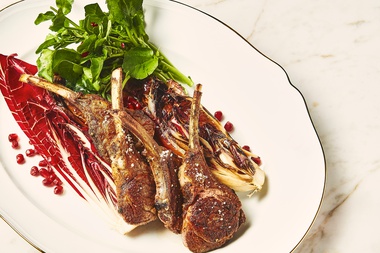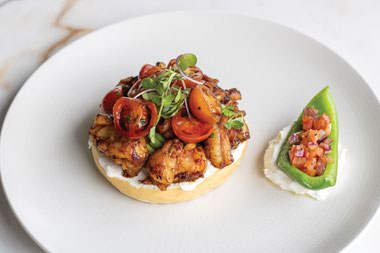It should be easy to eat healthy.We live in the richest nation in the history of humanity, and we benefit from a global supply chain that delivers the freshest produce and most exotic miracle foods year round. Yet it seems more difficult and confusing than ever to answer that eternal question: What’s for dinner?
Clean Eating
Las Vegas Weekly is here to ease your mind and fill your stomach. Our Clean Eating guide has everything you need to help you decide what, where and how to eat. We delve into the clean eating trend, first defining it and then offering need-to-know tips on how to apply it. We decode tricky health jargon, helping you learn the difference between organic and natural, vegan versus vegetarian. We’ll help you find the best grocery stores and restaurants for clean eating. (It’s easier to eat out and eat healthy than you think!) So read on and prepare to live a life where good tastes and good health go together like (gluten-free) cookies and (almond) milk.
So what exactly is it?
Simply put, the idea is to consume foods that are whole and natural in how they are derived. Think: close to the earth or with an ingredient list you can pronounce. The best stuff won’t even have an ingredient list—fruits, veggies, beans, lean meats and healthy oils. Some assume it’s a diet, but clean eating in its purest form is a lifestyle change that benefits your overall health and relationships with food. When eating clean, it’s important to keep in mind that you want to eat for nourishment and rely on balanced meals that provide fuel for your day, along with a variety of vitamins that improve your overall life.
How to get started?
1. Shop the perimeter of you grocery store, which houses fruits and veggies, butcher counters, dairy, eggs and other clean eating essentials. By avoiding the center aisles, you are avoiding processed and packaged food.
2. Cook your own food and be realistic about meal prep. Many individuals fall off the wagon because they set unrealistic goals, like cooking elaborate dinners every night. Meal-prep planning can prevent the fall. For example, roast enough veggies and chicken for multiple meals, or use a crockpot for a hearty veggie soup. Separate the feast into individual glass containers for convenient clean meals throughout the week without the daily cooking grind. Concerned about fits of hangry? Pick easy, healthy snacks to have on hand for quick access. Examples include organic nut butters and green apples or carrot sticks and hummus.
3. Avoid "diet" foods. If you want something, eat it in its purest form. That means avoiding processed foods labeled“diet,” “low-sugar,” “low-carb” and such. They’re often chemically engineered and loaded with artificial sweeteners and preservatives that are near impossible for the body to break down. If you want ice cream, it’s better to dive into one serving of real ice cream.
4. Eating out is still possible. Choose menu items that include organic fresh produce, healthy fats and lean proteins. And eat the rainbow! If you read that a meal has several veggies, you know you're getting an array of nutrients.
5. Focus more on balance and less on "good food, bad food" labels. Avocados and nuts are high in calories, which often gives them a bad rap, but they’re also equally high in fiber and healthy fats. Essential in a balanced diet, fats and fiber help fuel the body and keep you full between meals. When consumed in moderation, they’re better for you than processed snacks, so forget the “good” and “bad” labels associated with whole foods and focus on overall balance and moderation.
Is clean eating good for everyone?
Clean eating is good for everyone, but it still requires you to figure out what foods best agree with your body.
Kale and quinoa might be all the rage, but if they upset your stomach and make you feel bloated or uneasy, they might not be the match for you. Don’t feel shame. This isn’t uncommon. Many foods such as brown rice, red meats, corn, beans and raw veggies have a history of causing stomach upset. It’s best to figure out what works for your system using trial and error. If one healthy item doesn’t work, eliminate it and move on to another.
Clean food oils
Avoid canola oils, and instead opt for olive oil, avocado oil, coconut oil or ghee.
Yes, you can still have a burger
Clean eating doesn’t mean you can’t eat meat. It just means you should eat lean, organic meats void of added antibiotics. Examples include grass-fed beef, wild-caught salmon and organic chicken.
Okay with giving up the beef burger?
One of these lifestyle choices might be for you
• Pescatarian Consists of no animal meat or flesh, except for fish.
• Vegetarian No animal flesh or seafood.
• Vegan This one is the most restrictive and involves an entirely plant-based diet. No animal flesh or byproducts are eaten, including milk, cheese, eggs, and, for some strict vegans, even honey.
The problem with processed foods
Many processed or “dirty” foods are high in sugar, starches, trans-fats and chemicals. These food ingredients have been proven to trigger inflammation, which is linked to cardiovascular disease, cancer and diabetes, according to the National Institutes of Health. Clean eating rids your diet of this, giving it the fuel it needs to function at its highest level.
Keep an eye out for BPA
Bisphenol A is an industrial chemical that has been used to make certain plastics for the past 60 years.
According to research done by the Mayo Clinic, “Exposure to BPA is a concern because of possible health effects of BPA on the brain, behavior and prostate gland of fetuses, infants and children. Additional research suggests a possible link between BPA and increased blood pressure.”
Ditch your plastic water bottles, food containers and cans, unless they explicitly state they are “BPA-free.”
Health Benefits
The health benefits of clean eating are long and lasting. If you hop on the clean-eating wagon, first expect a reduction in body inflammation, which can be particularly important for individuals battling arthritis, diabetes, heart disease, high blood pressure, osteoporosis and cancer.
If you’re looking to lose a few pounds, clean eating might also provide a welcome boost. According to the CDC, one-third of adults in the U.S.—or 78.6 million people—are obese. Managing what you consume is the most direct way to take control of your body, and by cutting processed foods, you’re naturally eliminating items that are higher in calories. Rich in vitamins, minerals, phytochemicals and antioxidants, whole food items can also help curb cravings, speed up a slow metabolism and aid many health issues derived from obesity.
As a welcome side benefit, clearer skin might also be in your future. Sodium and trans-fat (found in most processed foods) often lead to acne and skin aging. Sugar breaks down the skin’s collagen, which then speeds up the formation of wrinkles and spots. Clean foods equal skin cell repair, or what most people call a clean skin “glow.”
"GM-NO"
Genetically modified organisms (GMOs) are plants or animals that have been altered in a lab through genetic engineering. In food, the practice has helped increase crop yields, pest resistance and size, helping to feed an ever-growing population. However, some scientists worry that the altered DNA in plants might somehow alter our own when consumed. Others argue that there is no proof that GMOs are unsafe. In fact, GMO foods are so prevalent that you’re likely eating them and didn’t know it. “It has been estimated upwards of 75 percent of processed foods on supermarket shelves” include GMO ingredients, according to the Center for Food Safety, . Common conventional GMO foods include: alfalfa, corn, cotton, potato, soy, sugar beet and zucchini.
The verdict is still out, but if you’re eating clean, the goal is to consume foods in their most pure form, so you should avoid GMOs by buying organic when possible.
Organic vs. natural: what's the difference?
Organic food must meet strict guidelines set by the U.S. Department of Agriculture and be grown or produced without synthetic fertilizers, genetic engineering, harmful pesticides, antibiotics, growth hormones and more. Farmers must also adhere to responsible farming practices and provide healthy living conditions for animals.
Foods labeled “natural” do not have artificial colors, flavors or preservatives, but production standards for those are not nearly as strict as for organic goods, and they can include GMOs,
Why does this matter? Pesticides used in agriculture have been associated with various forms of cancer, according to the National Center for Biotechnology Information, which recommends that “everyone, especially children and pregnant women, reduce exposure to pesticides whenever possible, both at home and in the workplace.”
Another benefit to eating organic? The Mayo Clinic states that organic foods have been shown to contain more nutrients than their conventional counterparts, along with increased flavonoids.








